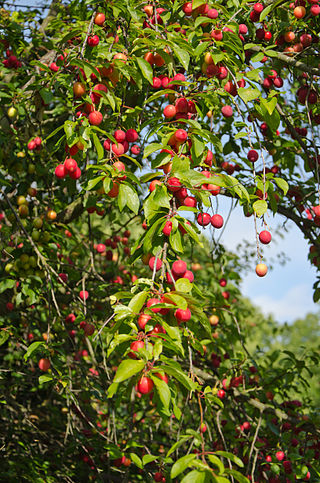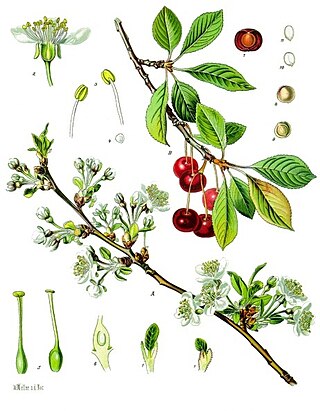
Rosaceae, the rose family, is a family of flowering plants that includes 4,828 known species in 91 genera.

A plum is a fruit of some species in Prunus subg. Prunus. Dried plums are often called prunes, though in the United States they may be labeled as 'dried plums', especially during the 21st century.

Prunus is a genus of trees and shrubs in the flowering plant family Rosaceae that includes plums, cherries, peaches, nectarines, apricots, and almonds. The genus has a cosmopolitan distribution, being native to the North American temperate regions, the neotropics of South America, and temperate and tropical regions of Eurasia and Africa, There are about 340 accepted species as of March 2024. Many members of the genus are widely cultivated for their fruit and for decorative purposes. Prunus fruit are drupes, or stone fruits. The fleshy mesocarp surrounding the endocarp is edible while the endocarp itself forms a hard, inedible shell called the pyrena. This shell encloses the seed, which is edible in some species, but poisonous in many others. Besides being eaten off the hand, most Prunus fruit are also commonly used in processing, such as jam production, canning, drying, and the seeds for roasting.

The cherry blossom, or sakura, is the flower of trees in Prunus subgenus Cerasus. Sakura usually refers to flowers of ornamental cherry trees, such as cultivars of Prunus serrulata, not trees grown for their fruit. Cherry blossoms have been described as having a vanilla-like smell, which is mainly attributed to coumarin.

Prunus subg. Padus is a subgenus of Prunus, characterised by having racemose inflorescences. Padus was originally a distinct genus, but genetic and morphological studies have shown that Padus is polyphyletic. It has been proposed that all the racemose taxa within Prunus are incorporated into a broad-sense Prunus subg. Padus.

Prunus cerasifera is a species of plum known by the common names cherry plum and myrobalan plum. It is native to Southeast Europe and Western Asia, and is naturalised in the British Isles and scattered locations in North America. Also naturalized in parts of SE Australia where it is considered to be a mildly invasive weed of bushland near urban centers. P. cerasifera is believed to one of the parents of the cultivated plum, Prunus domestica perhaps crossing with the sloe, Prunus spinosa, or perhaps the sole parent. This would make it a parent of most of the commercial varieties of plum in the UK and mainland Europe - Victoria, greengages, bullace etc.

Prunus serrulata or Japanese cherry is a species of cherry tree that grows naturally in Japan, China, Korea, and Vietnam, and it also refers to a cultivar produced from Prunus speciosa, a cherry tree endemic in Japan. Historically, the Japanese have developed many cultivars by selective breeding of cherry trees, which are produced by the complicated crossing of several wild species, and they are used for ornamental purposes all over the world. Of these, the cultivars produced by complex interspecific hybrids based on the Oshima cherry are also known as the Cerasus Sato-zakura Group.

Prunus serotina, commonly called black cherry, wild black cherry, rum cherry, or mountain black cherry, is a deciduous tree or shrub in the rose family Rosaceae. Despite being called black cherry, it is not very closely related to the commonly cultivated cherries, such as sweet cherry, sour cherry and Japanese flowering cherries, which belong to Prunus subg. Cerasus. Instead, P. serotina belongs to Prunus subg. Padus, a subgenus also including Eurasian bird cherry and chokecherry. The species is widespread and common in North America and South America.

Prunus incisa, the Fuji cherry, is a species of flowering plant in the family Rosaceae, which gets its scientific name from the deep incisions on the leaves. It is an endemic species in Japan and grows wild in Kantō, Chūbu and Kinki regions. It is called the Fuji cherry because it grows in particular abundance around Mount Fuji and Hakone. A dainty slow-growing, early white-flowering cherry tree, this century-old cultigen from Hondo, Japan is highly regarded as an ornamental but the wood has no industrial value. It is hardy to -20 °C, and crossed with Prunus speciosa, has yielded the cultivar Prunus 'Umineko'. It is in the ornamental section Pseudocerasus of the cherry subgenus Cerasus of the genus Prunus. Ma et al. classified it in a group with Prunus nipponica.

Prunus jamasakura, the Japanese mountain cherry, is a species of flowering plant in the family Rosaceae that is endemic to Japan.

Prunus tenella, the dwarf Russian almond, is a species of deciduous shrub in the genus Prunus, native to steppes of Eastern Europe and Western Siberia, as well as dry open sites of Caucasus, Western and Central Asia.

Prunus avium, commonly called wild cherry, sweet cherry or gean is a species of cherry, a flowering plant in the rose family, Rosaceae. It is native to Europe, Anatolia, Maghreb, and Western Asia, from the British Isles south to Morocco and Tunisia, north to the Trondheimsfjord region in Norway and east to the Caucasus and northern Iran, with a small isolated population in the western Himalaya. The species is widely cultivated in other regions and has become naturalized in North America, New Zealand and Australia.

Prunus pseudocerasus or Prunus pseudo-cerasus, the Chinese sour cherry or just Chinese cherry, is a species of cherry native to China, It is used worldwide as an ornamental for its early spring cherry blossoms. The fruit of some cultivars are edible.

Prunus × cistena, the purple leaf sand cherry or dwarf red-leaf plum, is a hybrid species of Prunus, the result of a cross between Prunus cerasifera and Prunus pumila. A deciduous leggy bush or shrubby tree, it typically reaches a height of 1.5–2.5 meters (5–8 ft) and has a useful life of 10–20 years. The fruits are edible, if strong-tasting. Some people make jams or preserves from them. It is not advisable to eat the pits.
Prunus veitchii, synonym Prunus xueluoensis, is a species of Prunus found in south-central and southeast China. It is a shrubby tree 0.5 to 3 m tall, preferring to grow at 1100 to 1500 m above sea level. It is morphologically similar to Prunus tomentosa and Prunus tianshanica. It differs from them by a number of features including having two to four flowers per inflorescence, many more stamens per flower, a glabrous pistil and a black fruit. Genetically, P. veitchii is more closely related to P. polytricha, P. jingningensis, and P. pseudocerasus.
Prunus rufoides, called Diel's cherry, the tawny bark cherry, and in Chinese: 尾叶樱桃, the tailed-leaf cherry, is a species of cherry native to China, preferring to grow at 500–1400 m above sea level, but reaching 1800 m. The fruits are eaten by masked palm civets and the fruits, leaves and buds are eaten by gray snub-nosed monkeys.

Prunus subg. Cerasus is a subgenus of Prunus. Species of the subgenus have a single winter bud per axil. The flowers are usually in small corymbs or umbels of several together, but some species have short racemes. The fruit is a drupe and has no obvious groove along the side. The subgenus is native to the temperate regions of the Northern Hemisphere, with two species in North America, four in Europe, two in North Africa, and the remainder in Asia.

Psychotria serpens, the creeping psychotria, is a species of flowering plant in the family Rubiaceae, native to Peninsula Malaysia, Southeast Asia, southeastern China, Hainan, Taiwan, the Ryukyu Islands, and central and southern Japan. A creeping or climbing perennial liana, it is typically found in thickets and forests, from 100 to 1,400 m above sea level. It is often substituted for "Caulis Trachelospermi" in traditional Chinese medicine preparations sold to people with cancer.
Prunus harae is a species of flowering plant in the family Rosaceae, native to Bhutan. A small tree that is similar to Prunus rufa, the Himalayan cherry, it typically found growing at 2,500 to 3,200 m above sea level.
Prunus pusilliflora, is a species of flowering plant in the family Rosaceae. It is native to Yunnan in China, where it is widespread, and is sometimes cultivated. A shrub or small tree reaching 3 to 10 m, it is typically found in forested mountain slopes and ravines, at elevations from 1,400 to 2,100 m. A chromosome-scale genome assembly study showed that it has better resistance to Colletotrichum viniferum, Phytophthora capsici, and Pseudomonas syringae pv. tomato than does Prunus avium, sweet cherry.















